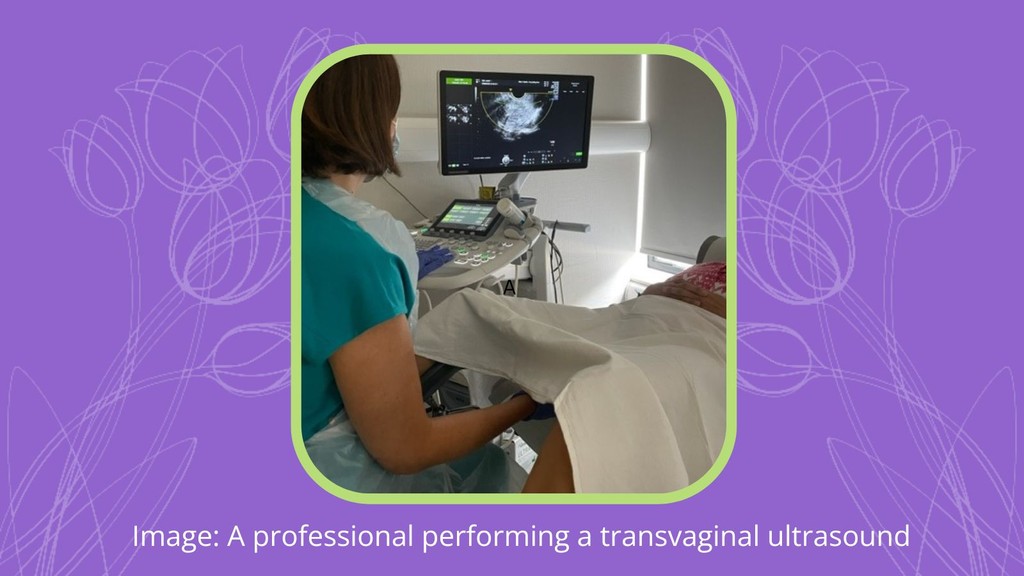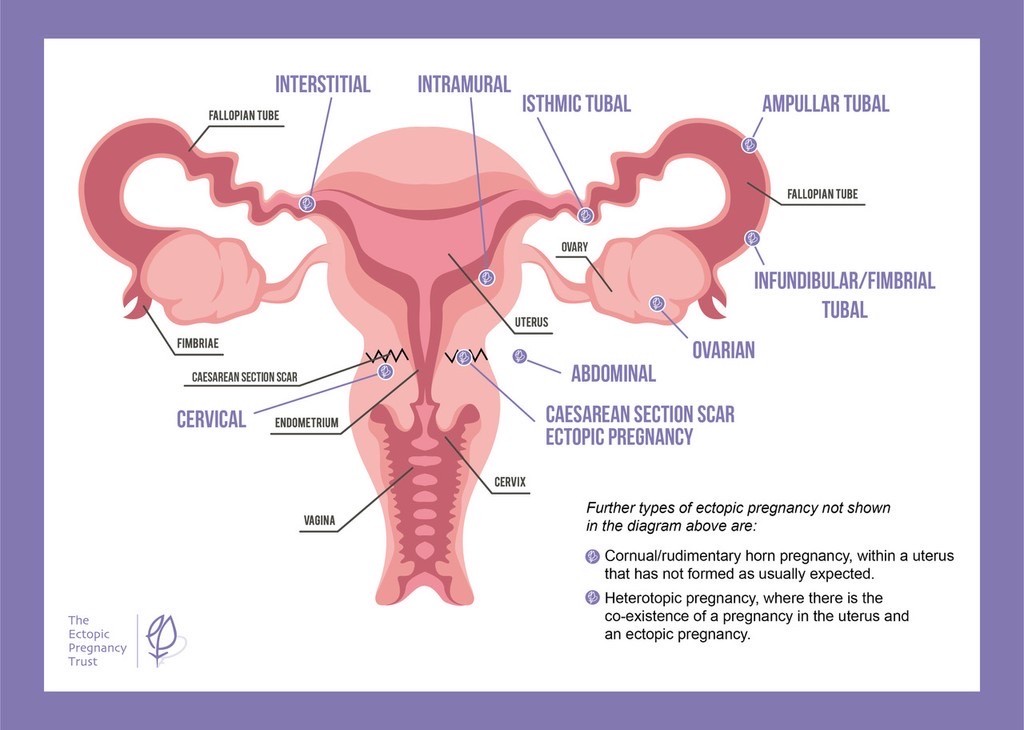Diagnosing ectopic pregnancy with ultrasound
At your first visit to the early pregnancy unit (EPU / EPAU) with symptoms of ectopic pregnancy, you will most likely be asked to have an internal ultrasound scan. The ultrasound scan will be used to identify where a pregnancy is located. If the pregnancy is in the right place and growing normally, the pregnancy sac can usually be seen around five days after your period was due. The embryo (baby) becomes visible about a week later.
If the scan does not show where the pregnancy is located, the medical team will suggest blood tests to monitor hCG levels and may need to repeat the scans. The hCG test is a blood pregnancy test, which identifies a person’s human chorionic gonadotropin (hCG) level. Healthcare staff monitor hCG levels to give an indication as to whether a pregnancy is progressing as it should. There is more information about Pregnancy of Unknown Location below.
Early diagnosis of ectopic pregnancy is really important and can save your life. It is crucial for you to take the medical advice given by the medical professional; whether it be the emergency department, doctor, or nurse. If you are advised to attend an early pregnancy assessment, then it is very important that you go to your appointment.
After the evaluation of an ectopic pregnancy, a nurse or doctor will discuss treatment choices with you if this are clinically safe and possible. Treatment options will depend on the extent of your symptoms, your blood test results, and scan findings. The clinicians who see you will help you decide which treatment for ectopic pregnancy is the most suitable option in your specific circumstances if more than one treatment route is possible.
Read more about treatments for ectopic pregnancy, including laparoscopic surgery, medical management with methotrexate treatment, and watchful waiting.
What is an ultrasound scan?
An ultrasound scan (sometimes called ultrasonography) is a medical procedure used to see inside your body. A device sends high-frequency sound waves through the body, which “bounce off” different internal parts of the body, creating a picture on a screen so that medical professionals can see what is happening. It is one of the most common investigations performed and it assists medical professionals in making an accurate diagnosis. It does not involve radiation, so there is no danger to a developing baby.
Most people are familiar with a transabdominal ultrasound scan – this is where a small device called a probe is placed on top of the lower abdomen (an external scan) which is then connected to a screen where images of the womb can be seen. There is also an internal scan called a transvaginal ultrasound scan which is also used for the diagnosis and management of ectopic pregnancy. This page has information about both types of scan, although the internal scan is most commonly used to diagnose an ectopic pregnancy because it gives a better view.
Preparing for an ultrasound scan
Although it is perfectly understandable that you might be worried about having an ultrasound scan, they do not hurt. You cannot hear or feel the sound waves, and they are not dangerous. The scan usually takes between 15 and 45 minutes. If possible, it is always a good idea to take someone with you for support.
With a transabdominal ultrasound scan, you will need a full bladder and will be asked to lie on a bed and move your clothing around your middle to make sure the abdomen (tummy area) and surrounding areas can be scanned fully. This is so that the internal reproductive organs can be seen clearly on the scan. You may be asked to remove some clothing but typically this is not necessary. A small amount of ultrasound gel is put either on your tummy or on the device itself. Then the person conducting the scan (usually a sonographer but can be any health professional) will roll the device over your lower tummy whilst observing the images on the screen.
You should also prepare for the fact that whilst the screen is next to the bed you will be lying on, the clinician might not show you the screen straight away – this is normal practice to give them time to find what it is they are looking for before letting you know.
In most cases, an internal scan (see information on transvaginal scans below) is needed for diagnosing an ectopic pregnancy. Sometimes, in emergency cases, a transabdominal scan may be carried out quickly to look for major bleeding as an initial assessment.
Transvaginal ultrasound scans
When there is the possibility of an ectopic pregnancy, to get a clearer picture of what is happening, it is often necessary to perform an internal scan known as a transvaginal ultrasound scan. This works the same way as an abdominal ultrasound but instead, the ultrasound probe is inserted into your vagina to get a closer view of the uterus (womb) and other reproductive organs. Vaginal ultrasound probes also use higher ultrasound frequencies and so the pictures obtained are clearer and give more detail.
Try not to worry about this procedure from a physical perspective – although we can understand that this can be a nerve-wracking prospect. Whilst they do not usually hurt, like a lot of gynaecology procedures, a transvaginal scan can be a little uncomfortable.
You will be asked to remove the clothing from your lower half then lie back on the examination bed, with a covering or sheet over your legs and tummy. You might be asked to either put your legs up in stirrups or bend your knees and let your legs fall out to the sides. This is so that the clinician can move the probe freely and that the pelvic muscles are as relaxed as possible.
It is a good idea to try and focus on taking calm, deep breaths during the procedure. You could focus on a spot on the ceiling and count to ten repeatedly in your head. Again, the probe will be cold as the clinician will put some lubricating gel on it to ease insertion and they may need to move it around a little inside you to get a clear image. Make sure you let them know if you are in any pain or discomfort.
Can you see an ectopic pregnancy on an ultrasound scan?
Yes, it is usually possible to see an ectopic pregnancy on a transvaginal ultrasound scan. The first transvaginal ultrasound scan will detect over 70% of ectopic pregnancies.
If however a pregnancy cannot be identified inside or outside the uterine cavity, it may be referred to as a Pregnancy of Unknown Location or PUL for short. This is not a diagnosis, just what doctors call the situation until they can identify the pregnancy’s location with certainty. It also does not mean that you definitely have an ectopic pregnancy; it just means doctors need to do more tests to find out where the pregnancy is.
You can read more about Pregnancy of Unknown Location here.
What do ectopic pregnancies look like on ultrasound scans?
The scan shows black and white images on the screen. The clinician will be trying to find whether there is evidence of pregnancy within the uterus (intrauterine or normally-sited) or elsewhere (extrauterine). They will be looking for signs of pregnancy in and around the uterus and reproductive organs.
The clinician will be looking for pregnancy tissue or structures of an early embryo, whether the uterus is empty, the endometrial thickness (lining of the uterus), or a gestational sac (first seen as a fluid-filled structure). They may see a small amount of free fluid present in the abdominal cavity. Early ultrasound is also used to locate and measure the yolk sac and size of an embryo if present. The scan is very important for your healthcare professional to locate your pregnancy and if necessary help to choose the right treatment.
The pregnancy may be found in one of the following places and you can read more about ectopic pregnancy locations here.
Tubal ectopic pregnancy
Tubal ectopic pregnancies occur when an embryo implants at some point along one of the Fallopian tubes. These are the tubes along which an egg travels from the ovary into the uterus. This is the most common type of ectopic pregnancy. The diagnosis of tubal pregnancy is when the sonographer identifies an adnexal mass (growth or lump around the uterus such as in a Fallopian tube) using transvaginal ultrasound.
Interstitial pregnancy
An interstitial pregnancy is a rare type of ectopic pregnancy that occurs when the fertilised egg implants in the part of the Fallopian tube as it crosses the wall of the uterus. For a personal experience of an interstitial pregnancy, read April’s story, which is an account of this kind of ectopic pregnancy.
Caesarean section scar ectopic pregnancy
Caesarean scar ectopic pregnancies are where the pregnancy has implanted partially or wholly in the scar tissue from a previous Caesarean section. While rare, this type of ectopic pregnancy is increasing in incidence.
Cervical ectopic pregnancy
A cervical ectopic pregnancy will be found in the cervix rather than within the uterus.
Cornual or rudimentary horn pregnancy
This is a rare type of ectopic pregnancy that only occurs in a uterus that has not formed as expected. A uterus that develops as expected is when two halves fuse together during early development. However, sometimes these two halves do not join up properly and this leaves one banana-shaped (unicornuate) side which is in contact with the cervix and vagina and another nubbin of uterus on the opposite side (that is not usually in contact with the cervix and vagina, called a rudimentary horn). Both sides have their own Fallopian tube. Sperm can reach deep inside via the one-sided uterus that is in contact with the vagina, but the opposite Fallopian tube may pick up the fertilised egg and transport it into the rudimentary horn where it cannot develop safely.
Abdominal ectopic pregnancy
Abdominal ectopic pregnancies are where the pregnancy has implanted in the abdominal lining or peritoneal cavity; an area of the body that sits over the abdominal organs. These types of ectopic pregnancy are rare.
Intramural ectopic pregnancy
Intramural ectopic pregnancies occur in the walls of the uterus rather than in the uterine cavity itself and is a very rare type of ectopic pregnancy.
The incidence of rarer types of ectopic pregnancy, such as heterotopic pregnancy (where there is one pregnancy within the uterine cavity and another outside the uterus) and Caesarean section scar ectopic pregnancy, are growing as a result of the rising number of women who have Caesarean section deliveries and the growing number of people who have in vitro fertilisation (IVF) procedures.
What if an ultrasound scan does not identify an ectopic pregnancy?
If it is not possible to identify an ectopic pregnancy using an ultrasound scan, further tests will be conducted and you will be monitored until medical staff can identify where the pregnancy is located.
On occasion, it will continue not to be clear where the pregnancy is located despite scans and blood tests. In these circumstances, your doctors may suggest a diagnostic laparoscopy. Diagnostic laparoscopy is a type of keyhole surgery which involves a small incision in the abdomen through which a camera is inserted to see inside the abdominal cavity and take a close look at the reproductive organs. Whilst we understand that the prospect of this procedure can be frightening, your doctor and the medical team should be able to advise you every step of the way.
You are not alone
If you are currently going through the process of a suspected ectopic pregnancy, or have recently had an ectopic pregnancy confirmed, you are not alone. Please explore our range of online resources that we hope can help you through this difficult time:
- Our dedicated page on diagnosing an ectopic pregnancy is full of information about diagnosis that other people have found very useful
- Our treatment of an ectopic pregnancy page can help you understand more about treatment options
- Our online forum is free and easy to use, where you can read more about other people’s experiences and reach out for support from others
- Our online stories are written by brilliantly brave and honest people who have gone through an ectopic pregnancy and have been willing to share their accounts
If you are going through an ectopic pregnancy, you are not alone. Seek help from the many resources The Ectopic Pregnancy Trust has to offer.
Other pages you may find helpful
Find out about different treatment options including expectant management, medical management with methotrexate, and surgical treatment
Pelvic pain and/or abdominal pain and/or vaginal bleeding during pregnancy may be due to a number of causes. Read more here about ectopic pregnancy symptoms
Read more about the reasons and risk factors for an ectopic pregnancy
Pregnancy of Unknown Location Downloadable PDF


